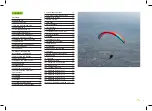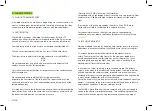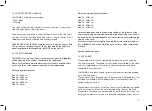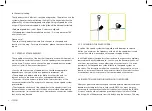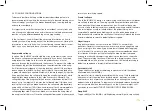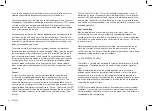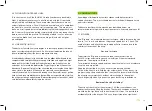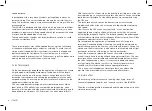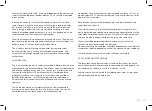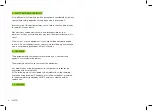
11
4.2 POSSIBLE CONFIGURATIONS
To become familiar with the possible incidents described below, we
recommend practising within the environment of a licensed training outfit.
You must adapt your use of the brakes depending on the wing-loading
and avoid over-steering.
It is important to note that the reaction to an incident can vary from one
size of wing to another and even within the same size the behaviour and
reactions may be different depending on the wing-loading.
In the test report, you will find all the necessary information on how to
handle your new wing during each of the tested manoeuvres. Having this
information is crucial to know how to react during these incidents in real
flight, so you can deal with these situations as safely as possible.
Asymmetric collapse
In spite of the IKUMA 2’s profile stability, strong turbulent air may cause
the wing to collapse asymmetrically, especially if you do not fly actively
and prevent the collapse. In this case the glider conveys a loss of
pressure through the brake lines and the harness. To prevent the collapse
from happening, pull the brake handle on the affected side of the wing.
It will increase the incidence of the wing (angle of attack). If the collapse
does happen, the IKUMA 2 will not react violently, the turning tendency
is gradual and easily controlled. Weight-shift toward the open, flying side
(the opposite side of the collapse) to keep the wing flying straight, while
applying light brake pressure to that side if necessary. Normally, the
collapsed side of the wing should then recover and reopen by itself. If it
does not, try to weight-shift towards the collapsed side. If this does not
resolve the issue, pull the brake handle on the collapsed side decisively
and quickly all the way (100%) down and release it back up immediately.
You may have to repeat this action to provoke the re-opening of the
collapsed glider side. Do not over-brake or slow down the flying side of
the wing (control the turn). Once the collapsed side is open make sure you
return to normal flying speed.
Frontal collapse
Due to the IKUMA 2 ’s design, in normal flying conditions frontal collapses
are unlikely to take place. The wing’s profile has great buffering abilities
when dealing with extreme incidence changes. A frontal collapse may
occur in strong turbulent conditions, entering or exiting powerful thermals.
Frontal collapses usually re-inflate without the glider turning, but a
symmetrically applied quick braking action with a quick deep pump of
both brakes will accelerate the re-inflation if necessary. Release the brake
lines immediately to return to default glider air speed.
Negative spin
A negative spin does not conform to the IKUMA 2 ’s normal flight
behaviour. Certain circumstances however, may provoke a negative spin
(such as trying to turn when flying at very low air speed whilst applying
a lot of brake). It is not easy to give any specific recommendation about
this situation other than quickly restoring the wing’s default air speed
and angle of attack by progressively reducing the tension on the brake
lines. The normal wing reaction will be to have a lateral surge on the re-
accelerated side with a rotation not greater than 360º before returning to
default air speed and a straight flight path trajectory.
Parachutal stall
The possibility of entering or remaining in a parachutal stall have been
eliminated from the IKUMA 2 .
A parachutal stall is virtually impossible with this wing. If it did enter into
a parachutal stall, the wing loses forward motion, becomes unstable
and there is a lack of pressure on the brake lines, although the canopy
appears to be fully inflated. To regain normal air speed, release brake line
tension symmetrically and manually push on the A-lines or weight-shift
your body to any side WITHOUT PULLING ON THE BRAKE LINES.
Deep Stall
The possibility of the IKUMA 2 stalling during normal flight is very unlikely.
Summary of Contents for IKUMA 2
Page 1: ...IKUMA 2 User s manual...
Page 19: ...19...
Page 22: ...10 3 RISERS PLAN 22...
Page 23: ...10 4 SUSPENSION PLAN 23...
Page 29: ...niviuk com...



